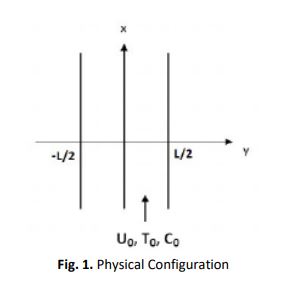Flow Reversal of Fully Developed Combined Convection in a Vertical Channel with Boundary Condition of a Third Kind
DOI:
https://doi.org/10.37934/arfmts.91.1.5668Keywords:
Combined Convection, Vertical Channel, Boundary Conditions of Third Kind, Heat GenerationAbstract
The heat transfer process of combined convection and its flow pattern in a vertical channel is important, especially in environmental, industrial and engineering applications. There has been some concern regarding the heat transfer process in which it is difficult, expensive and time consuming. There are three main objectives to satisfy the purpose of this study which are to determine the impact on flow and heat transfer of the Robin temperature boundary condition, to verify whether the viscous dissipation plays a classical role in fluid flow and heat transfer and lastly to compare the degree of heat transfer facilitated by the boundary conditions of Dirichlet, Neumann and Robin. In this study, the effects of different dimensional parameters were tested and the flow reversal phenomenon was discussed. The Boundary Value Problem (BVP) was solved numerically using Maple using a built-in routine, dsolve. Validation study to the previously published problem was carried out to verify the accuracy of the present computation. The transformation of partial differential equation to ordinary differential equation involved similarity technique. The numerical results of the flow and temperature variables were presented graphically. The flow reversal occurred when the value of internal heat generation (G) and combined convection parameter (λ) were large. There was no occurrence of flow reversal when the values of local heating exponent (p) and the Biot Numbers (Bi) increase. However, the value of mass transfer coefficient (N) was different, gave no significant impact.
Downloads

































